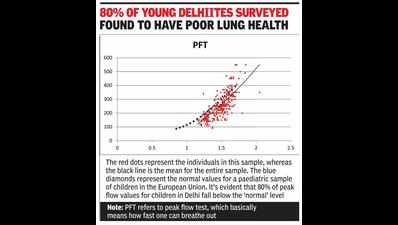- News
- City News
- delhi News
- Why Delhi kids have weaker lungs than EU’s
Trending
This story is from February 8, 2018
Why Delhi kids have weaker lungs than EU’s
NEW DELHI: Even as the Centre claims that there is no direct link between diseases and air pollution, the Delhi-based Hazard Centre and some independent researchers have released a study highlighting how severe pollution levels at 15 locations along eight arterial roads and two Ring Roads are affecting lives.
The study — released on Wednesday — also found that, on average, lung function among a majority of the over 300 children and young adults tested is far lower than the normal values for European children.The study was conducted with a network of low-cost air monitors between October and November 2017. It found that there is a base pollution load across Delhi of about 300µg/m³ for PM10 and 200µg/m³ for PM2.5, which is three times higher than the national standard.

“There was an overall spike in pollution levels to above 600µg/m³ for PM2.5 on November 8, and a smaller increase up to 500µg/m³ on November 12, and both were much higher than the one on Diwali on October 19,” the study found. In fact, at Guru Tegh Bahadur Nagar on Ring Road, one of the low-cost monitors recorded a spike of 2,000µg/m³ in January 2018, but experts said that it could also be an anomaly.
Experts said low-cost sensors estimate the pollution levels at the breathing height whereas high-volume air samplers of government agencies assess the pollution 5-6 metres above the ground. The low-cost devices yield data that are lower than the DPCC monitors, about the same as the IMD ones, and higher than the CPCB monitors. But the patterns are more or less the same, they found.
The team also carried out a quick health study at 11 locations with 343 individuals below the age of 20 years who walk to school or college in the area. They found that 80% of the “peak flow” (how fast you can breathe out) values for children in Delhi fall below what is considered ‘normal’ for European children. “This may partly be due to demographic differences, but one would not expect such a large difference in the city with the highest per capita income in the nation,” a Hazard Centre expert said. Compared to those in west and east Delhi, those tested in the southern and northern peripheries had slightly better lung function results.
The data analysis also revealed that, across Delhi, there is a spike in the morning hours between 8am and 10am, a dip in the afternoons between 2pm and 4pm, and another spike in the evening hours between 7pm and 9pm. The pollution loads are highest in places like Bahadurgarh and Punjabi Bagh in the west, GTB Nagar and Wazirpur in the north, Kalyanpuri in the east, and New Friends Colony in the south — all of them being characterised by heavy traffic on arterial roads. The air is relatively the cleanest in Holambi and Bhalswa in far north. Saket, Tughlakabad, and Ayanagar in south have slightly higher pollution but the peaks are comparatively lower.
The study — released on Wednesday — also found that, on average, lung function among a majority of the over 300 children and young adults tested is far lower than the normal values for European children.The study was conducted with a network of low-cost air monitors between October and November 2017. It found that there is a base pollution load across Delhi of about 300µg/m³ for PM10 and 200µg/m³ for PM2.5, which is three times higher than the national standard.

“There was an overall spike in pollution levels to above 600µg/m³ for PM2.5 on November 8, and a smaller increase up to 500µg/m³ on November 12, and both were much higher than the one on Diwali on October 19,” the study found. In fact, at Guru Tegh Bahadur Nagar on Ring Road, one of the low-cost monitors recorded a spike of 2,000µg/m³ in January 2018, but experts said that it could also be an anomaly.
The locations monitored by the team included Holambi, Bhalswa, Wazirpur, Punjabi Bagh, GTB Nagar, Bahadurgarh, Seelampur, Seemapuri, Kalyanpuri, Patparganj, New Friends Colony, Tughlaqabad, Saket, Munirka and Ayanagar. These locations were chosen because they were close to schools or colleges and there were Delhi Pollution Control Committee, IMD or Central Pollution Control Board monitors that could be used as reference.
Experts said low-cost sensors estimate the pollution levels at the breathing height whereas high-volume air samplers of government agencies assess the pollution 5-6 metres above the ground. The low-cost devices yield data that are lower than the DPCC monitors, about the same as the IMD ones, and higher than the CPCB monitors. But the patterns are more or less the same, they found.
The team also carried out a quick health study at 11 locations with 343 individuals below the age of 20 years who walk to school or college in the area. They found that 80% of the “peak flow” (how fast you can breathe out) values for children in Delhi fall below what is considered ‘normal’ for European children. “This may partly be due to demographic differences, but one would not expect such a large difference in the city with the highest per capita income in the nation,” a Hazard Centre expert said. Compared to those in west and east Delhi, those tested in the southern and northern peripheries had slightly better lung function results.
The data analysis also revealed that, across Delhi, there is a spike in the morning hours between 8am and 10am, a dip in the afternoons between 2pm and 4pm, and another spike in the evening hours between 7pm and 9pm. The pollution loads are highest in places like Bahadurgarh and Punjabi Bagh in the west, GTB Nagar and Wazirpur in the north, Kalyanpuri in the east, and New Friends Colony in the south — all of them being characterised by heavy traffic on arterial roads. The air is relatively the cleanest in Holambi and Bhalswa in far north. Saket, Tughlakabad, and Ayanagar in south have slightly higher pollution but the peaks are comparatively lower.
End of Article
FOLLOW US ON SOCIAL MEDIA












